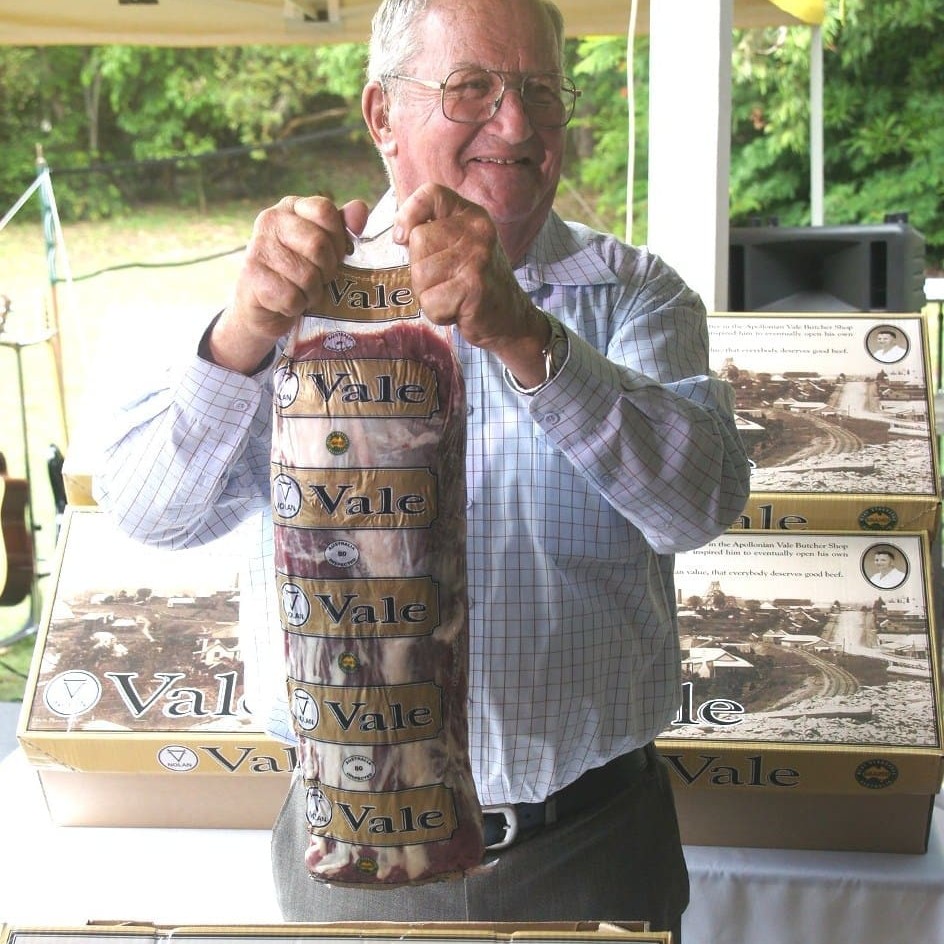 The chance to sit down and chew the fat last week with Pat Nolan, founder of one of Australia’s most successful family-owned processing businesses provided a local snapshot of how the beef industry has changed over half a century.
The chance to sit down and chew the fat last week with Pat Nolan, founder of one of Australia’s most successful family-owned processing businesses provided a local snapshot of how the beef industry has changed over half a century.
The occasion was the launch of Nolan Meats’ new Vale MSA brand, discussed in Beef Central on Friday last week “Brand extension drives new beef brand.”
During our yarn over a cold beer, Pat, now well into his 80s, lamented the loss of meat businesses in the local district.
In many ways, Gympie, it appears, is a microcosm of what has happened across regional Australia.
As a young, ambitious butcher Pat and his charming wife Marie started in a retail meat business near Gympie’s Apollonian Hotel in 1958, in what appeared to be a fiercely competitive retail market at the time.
Five years later, in 1963, he bought a small abattoir on East Creek road, the embryo of a business that would later develop into Nolan Meats – today processing 450 MSA cattle a day and employing more than 200 staff.
Pat rattled-off the names of local Gympie butchers operating circa 1958: Gibson (Stewart Tce); Gillman (Horseshoe Bend); Herbert (Duke St); Dodt's, Gerrard & Sullivan, Alec Black, Drummond & Park, McGeary, Lane & Ward (six butchers all located in Mary St, alone); Ernie Hallet (Smithfield St); Lane & Ward (Mellor St); Lobb (Tozer Park Rd); Bob Biggers; Viv Weller (Apollonian Vale); Tom Wynn (Mt Pleasant); Gordon Butler (River Rd); Geo Weller (Monkland); and Pat MacDonnell (Southside).
That’s no less than 18 butchery businesses, but in an era, of course, when no supermarkets existed.
It’s difficult to know, precisely, how many citizens lived in Gympie, circa 1958. But gold mining was well and truly on the wane by that stage, and population would have been considerably smaller than it was at the start of the century.
What we do know is that 30 years ago, around 1982, the ‘City’ of Gympie had about 11,000 residents. The number today is close to 20,000, with perhaps another 20,000 in the surrounding district.
Despite a doubling in immediate population over 30 years, there are just six independent butchers remaining in the Gympie CBD today. The balance of meat trade, of course, goes through the three large, modern supermarkets in town operated by Coles, Woolworths and IGA.
One could argue that each of the supermarkets accounts for ‘multiples’ of smaller independent shops, both in turnover and numbers of staff employed. But given that much of today’s supermarket red meat offer is retail-ready MAP packaged in a centralised processing facility 160km away in Brisbane, that does little to stimulate local employment – via the meat counter, at least.
The same trend is evident in the decline in slaughter yards servicing the local population.
Pat recalls that there were four businesses in the immediate Gympie area offering contract slaughter for customers back in 1958: Wynn (Keefton); Gibson (Fisher Rd); Lane & Ward (Old Wolvi Rd); Gerrad & Sullivan (Fraser Rd).
In the surrounding region (granted, a much bigger area, stretching out as far as Bundaberg and Murgon) there was an unbelievable 17 more slaughter yards in operation. Pat remembered them all: Lennox (Pomona), Pidgeon (Imbil), Cordell (Kandanga), Shepherdson (Kin Kin), Connors (Tiaro), a business at Gunalda), Anstey (Tansey Abattoir), Staib (Maryborough), Swifts (Maryborough abattoir), South Burnett Co-op (Murgon abattoir), a business at Maleny, Aldous (Landsborough), Bryant (Cooroy), Bundaberg Regional Abattoir (Bundaberg), a business at Biggenden, Smyth (Kilkivan) and Kessels (Woolooga).
Many may have killed no more than 20-40 head of cattle a week, Pat thought.
Of the recent survivors, Cooroy and Landsborough stopped a few years back and Gray’s at Eumundi finished about a fortnight ago.
That means there is no slaughter facility at Bundaberg, Maryborough or the Sunshine Coast – all large population centres. Kilcoy obviously operates as the cloests exporter to Gympie and Biggenden is the closest domestic service kill operator.
In the modern age of heightened food safety, regulatory pressures and efficiency driven by the need for high meatworks utilisation, it is almost impossible to imagine how so many small, low-throughput businesses could have survived. But survive they did, no doubt putting bread on the table for a local family, and delivering a considerable measure of local employment.
